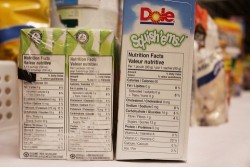In what seems like a move following pace with Health Canada, the U.S. Food and Drug Administration has announced a plan to redo the nutrition facts panel to include added sugars in it.
The FDA’s consumer study confirmed what an earlier study by IFIC foundation had shown in testing consumer comprehension of added sugars labelling.
MORE INDUSTRY NEWS
- New vending machines in Europe serve fresh organic produce
- Pet treats market exceeded $5 billion in 2014
- Organic personal care products are the fastest growing segment of the personal care industry
The central point to the added sugars labelling was the attempt at assessing how labelling added sugars in products affects the ability of consumers to identify the total number of sugars in what they’re buying.
[blockquote style=”center” color=”#0f0606″ bg_color=”#f5eded” border_color=”#b80d0d”]“A key question to answer in our consumer research is whether or not an ‘Added Sugars’ declaration on the NFP provides clear information that is well understood by consumers that would be used appropriately in efforts to make informed dietary choices,” said co-author Kris Sollid, RD, IFIC Director of Nutrients Communications. “The short (and sweet) answer…providing added sugars information significantly decreases the ability for consumers to accurately identify the total amount of sugars in a product.”[/blockquote]
Research shows that when asked to identify the total amount of sugars in a product, 92 per cent respondents were able to do so correctly when viewing the current label format where ‘sugars’ are listed and ‘added sugars’ are not.
However, fewer than 55 per cent people were able to get it correct when viewing a label that identified ‘sugars’ and ‘added sugars’ separately.
In Canada, nutrient labelling has recently undergone several changes. The movement has required all labels to clearly identify the daily nutritional value for consumers, focusing on per cent daily value and serving size. The Canadian government believes that giving this information on nutritional labels will help consumers choose foods that have more of the nutrients they want, such as fibre and calcium, and less of those they don’t want, such as saturated and trans fats and sodium.









